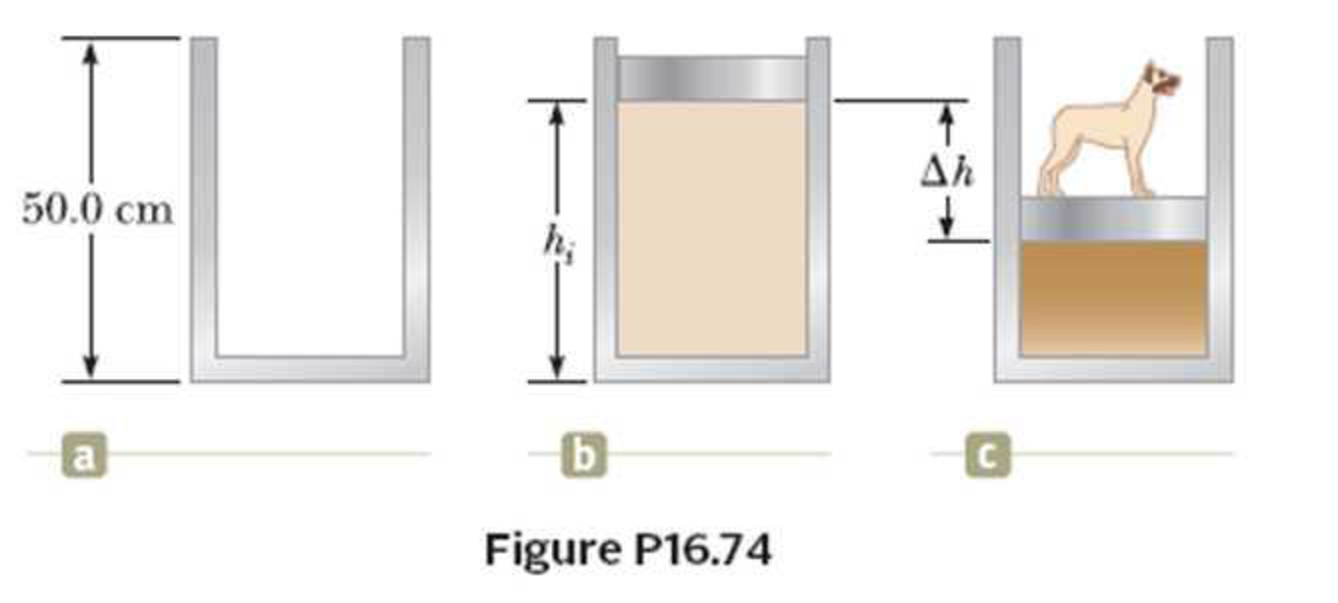
Concept explainers
A cylinder that has a 40.0-cm radius and is 50.0 cm deep is filled with air at 20.0°C and 1.00 atm (Fig. P10.74a). A 20.0-kg piston is now lowered into the cylinder, compressing the air trapped inside as it takes equilibrium height hi (Fig. P16.74b). Finally, a 25.0-kg dog stands on the piston, further compressing the air, which remains at 20°C (Fig. P16.74c). (a) How far down (Δh) does the piston move when the dog steps onto it? (b) To what temperature should the gas be warmed to raise the piston and dog back to hi?

(a)
The height which the piston moves down when the dog steps onto the piston.
Answer to Problem 74P
The height at which the piston move down when the dog steps onto the piston is
Explanation of Solution
Write the expression for Boyle’s law, for the initial and final state since the temperature is constant.
Here,
Use
Here,
When the piston moves down, then the external pressure on the piston is
Equate the equation (II) with the equation
Replace the mass
Here,
The piston moves downward when the dog steps on the piston. It can be expressed as,
Use equation (III) and (IV) in (V).
Conclusion:
Substitute,
Therefore, the height at which the piston move down when the dog steps onto the piston is
(b)
The temperature at which the gas should be warmed to raise the piston and dog back to
Answer to Problem 74P
The temperature at which the gas should be warmed to raise the piston and dog back to
Explanation of Solution
Write the expression for Charles’s law, for the initial and final state since the pressure is constant.
Here,
Use
Use equation (III) and (IV) in the equation (VIII).
Conclusion:
Substitute,
Therefore, The temperature at which the gas should be warmed to raise the piston and dog back to
Want to see more full solutions like this?
Chapter 16 Solutions
Bundle: Principles of Physics: A Calculus-Based Text, 5th + WebAssign Printed Access Card for Serway/Jewett's Principles of Physics: A Calculus-Based Text, 5th Edition, Multi-Term
- The faster a molecule is moving in the upper atmosphere, the more likely it is to escape Earth's gravity. Given this fact, and your knowledge of rms speed, which of the following molecules can escape most easily from Earth's atmosphere if they are all at the same temperature?arrow_forwardThe temperature in one part of a flame is 2,100 K. What is the rms velocity of the carbon dioxide molecules at this temperature? Give your answer as the number of meters per second. mass of 1 mole of CO2 = 44.0 grams 1 mole contains 6.02 x 1023 molecules the Boltzmann constant k = 1.38 x 10-23 J/Karrow_forwardThe specific heat of a certain substance is 375 J/(kg°C). How much heat energy would you have to add to increase the temperature of 22 kg of this substance from 33°C up to 44°C in a number of Joules?arrow_forward
- 3.9 moles of an ideal gas are sealed in a container with volume 0.22 m3, at a pressure of 146,000 N/m2. What is the temperature of the gas in degrees Celsius?arrow_forwardwhen a cannon is launched at a 65 degree angle, will it have the same horizontal velocity as when it is launched from a 25 degree angle as long as the initial speed is the same?arrow_forwardPlease solve the problem step by step and provide explanations along each step stating what's being done. Thank you!!arrow_forward
- Figure 8.14 shows a cube at rest and a small object heading toward it. (a) Describe the directions (angle 1) at which the small object can emerge after colliding elastically with the cube. How does 1 depend on b, the so-called impact parameter? Ignore any effects that might be due to rotation after the collision, and assume that the cube is much more massive than the small object. (b) Answer the same questions if the small object instead collides with a massive sphere.arrow_forward2. A projectile is shot from a launcher at an angle 0,, with an initial velocity magnitude vo, from a point even with a tabletop. The projectile hits an apple atop a child's noggin (see Figure 1). The apple is a height y above the tabletop, and a horizontal distance x from the launcher. Set this up as a formal problem, and solve for x. That is, determine an expression for x in terms of only v₁, 0, y and g. Actually, this is quite a long expression. So, if you want, you can determine an expression for x in terms of v., 0., and time t, and determine another expression for timet (in terms of v., 0.,y and g) that you will solve and then substitute the value of t into the expression for x. Your final equation(s) will be called Equation 3 (and Equation 4).arrow_forwardDraw a phase portrait for an oscillating, damped spring.arrow_forward
 Principles of Physics: A Calculus-Based TextPhysicsISBN:9781133104261Author:Raymond A. Serway, John W. JewettPublisher:Cengage Learning
Principles of Physics: A Calculus-Based TextPhysicsISBN:9781133104261Author:Raymond A. Serway, John W. JewettPublisher:Cengage Learning Physics for Scientists and EngineersPhysicsISBN:9781337553278Author:Raymond A. Serway, John W. JewettPublisher:Cengage Learning
Physics for Scientists and EngineersPhysicsISBN:9781337553278Author:Raymond A. Serway, John W. JewettPublisher:Cengage Learning Physics for Scientists and Engineers with Modern ...PhysicsISBN:9781337553292Author:Raymond A. Serway, John W. JewettPublisher:Cengage Learning
Physics for Scientists and Engineers with Modern ...PhysicsISBN:9781337553292Author:Raymond A. Serway, John W. JewettPublisher:Cengage Learning Physics for Scientists and Engineers: Foundations...PhysicsISBN:9781133939146Author:Katz, Debora M.Publisher:Cengage Learning
Physics for Scientists and Engineers: Foundations...PhysicsISBN:9781133939146Author:Katz, Debora M.Publisher:Cengage Learning College PhysicsPhysicsISBN:9781285737027Author:Raymond A. Serway, Chris VuillePublisher:Cengage Learning
College PhysicsPhysicsISBN:9781285737027Author:Raymond A. Serway, Chris VuillePublisher:Cengage Learning





